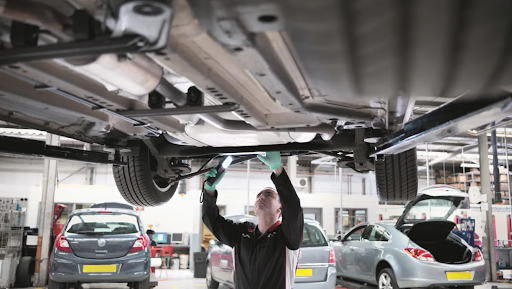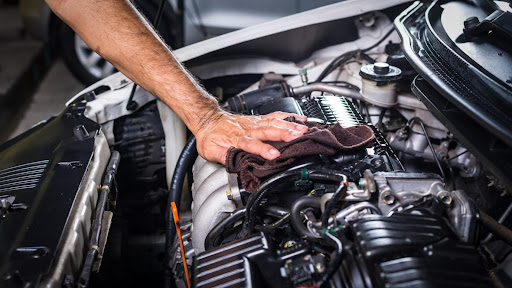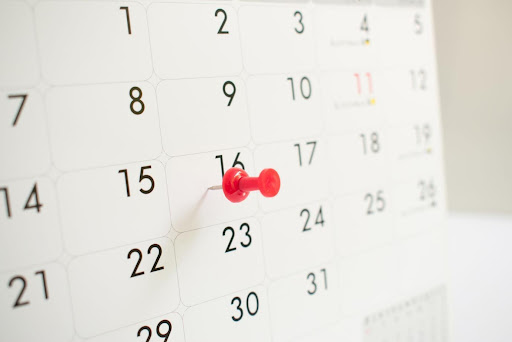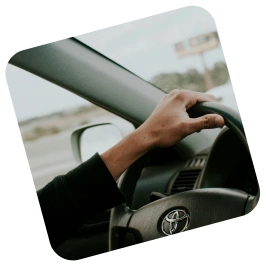If your car is more than three years old, in the UK, you are required to take an annual MOT (Ministry of Transport) test. And if you have one coming up, you probably want to know what car parts will be checked - so that you can prepare.
To assess the roadworthiness of your car, the MOT tester will look at the interior, exterior, and underside of the vehicle. But when you go into more detail, there are actually dozens of MOT checks - from the brakes to the mirrors.

What do they check on an MOT?
All MOT testers carry out an efficiency inspection by following a standard checklist. This section will cover the most critical parts of that list.
1.Lamps & signals
All lamps (headlights, tail lights, indicators) must emit light of the same colour and intensity and be of the same size & shape (applies to the same type of lights) and be symmetrical to each other. They must be securely attached, none must be missing, and no more than a half can be inoperative in the case of LEDs.
The beam mustn’t be higher or significantly lower than the horizontal line; steer to the right or to the left by more than 2% from the vertical line.
2.Electrical equipment
The electrical wiring, connectors and battery will first be assessed visually. The operation of devices involving electronics (parking brake, stability control, steering lock, monitoring systems, vision devices, mirrors levelling, etc.) is also examined.
Here is what type of wirings counts as defective: inadequately secured, deteriorated, likely to cause a short-circuit, disconnected, forming sparks, touching hot or rotating parts, or dragging on the ground.
3.Steering and suspension
Steering bearings, bolts, clamps, gaiters, and universal joints are examined visually, and the operation of the power steer is examined after running the engine. All the components must be free of excessive wear, and the steering rack must be free from oil leaks. There should be no free play, which would otherwise mean the steering wheel and column are fixed improperly.
The suspension system will be inspected alongside the steering components. The sprigs must have no advanced corrosion or breakages, as must the top and bottom suspension mountings.
4.Brakes
The brakes are examined for their condition and performance. The MOT inspector will check all braking components, including the brake servo unit, master cylinder, pipes, and pedals, for wear, excessive movement, leakage, etc.
The first test is an inspection of the physical components, and the second test assesses brake efficiency. The second is usually carried out by rolling road brake testing equipment. It will take a reading from each wheel to evaluate efficiency and balancing.
5.Tyres
The tyres must be the same size and have no significant cuts or bulges (for example, if any ply or cord is visible without you touching the tyre, the car will fail the test. In the context of MOT checks, tyre flexing or suspension movement is not considered a defect.
Spare tyres are not checked in detail, but they must be mounted securely (unless stored inside the car).
6.Wheel
The wheels must have no loose or missing nuts, bolts or studs, no distortion or cracks, and no damage to wheel bearings. If any of the wheels are not correctly fitted or likely to come off, the MOT tester will mark it as a defect.
The wheel and all of its fixings must be compatible, not distorted or worn to the point of suddenly getting detached.
7.Vehicle identification number (VIN)
A VIN (or chassis number) is required on all vehicles first used on or after 1 August 1980 and amateur-built cars. You only need one to be displayed and legible, but there may be more than one on different parts of the car. But only multi-stage build vehicles can have two different VINs.
8.Visibility
This point covers the field of vision, the view to the rear, windows on either side of the driver’s seat, the condition of the glass, and indirect vision devices. There should be no damage, excessive tinting, or discolouration. Nothing should restrict the driver’s view, including the sun visor, signs, stickers, or wipers.
If your car has vision cameras, the MOT tester must inspect them from the outside and the screen they display images on.
9.Seats and seat belts
The driver’s seat must be adjustable, and all seats should be secured in the upright position. The structure must not be defective, causing the seats to move inadvertently. The security of all possible positions and the memory position will not be checked.
As for the seatbelts, none should be missing, they should work properly, fit the vehicle, be in good condition, and be attached securely. The clip/locking mechanism will also be checked. The anchorage must be unlikely to get detached in the event of a collision.
10.Registration plates
The registration places must not be excessively damaged, obscured, delaminated, or deteriorated. Aside from their condition, the MOT tester will look if they are securely attached, have the proper colour, and the numbers and letters must be properly spaced. Overall, the plates must be easy to read.
11.Exhaust system
The exhaust system must be free from serious corrosion and be fixed to the vehicle as intended using exhaust mounts or the common rubber fitting mounts. At the examiner’s discretion, excessive noise (if there is not an adequate number of silencers required for your specific car) can be considered a defect.
12.Exhaust emissions
Petrol cars used before August 1975 and diesel cars used before January 1980 are checked visually. Visible smoke from the tailpipe typically counts as a fail. More modern cars are tested by a meter.
The metered test consists of running the engine at a speed of 2,500-3,000 rpm to check the emissions at fast-idle speed. If you think the smoke test may damage your engine, you should tell the MOT inspector in advance.
13.Fuel system
The entire fuel system will be examined for safety and potential leak sources. The pipes and hoses must be in good condition and sealed securely. The MOT tester will look at fuel lines along the vehicle to assess whether there is any damage that could result in a fire risk.
The system must be complete with a proper fuel filler cap.
14.Load security
To reduce the risk of insecure loads, the vehicle’s boot or tailgate should also be checked. They must be shut security, with no inappropriate repairs or modifications.
15.Horn
The sound emitted by the horn must be continuous or uniform, loud enough for other vehicles on the road and pedestrians, and suitable for the vehicle. The sound of gongs, bells, sirens, or anything that has more than one tone is not allowed. And, of course, it must work properly.
16.Bodywork
This point includes the inspection of all body panels, undertrays, spoilers, and mirror housings. No body components can have damage or erosion, cause injury if contacted, or be likely to get detached. There must be no unsafe modifications that can negatively affect braking, steering, or load stability.
Elements like boot lid, tailgate, dropside, loading door, and access panel must be securely attached, especially when they are shut.
17.Towbars
The MOT inspector will assess the secureness, condition (damage, corrosion), and any modifications. They will check all coupling mechanisms and towbars fitted to the rear of a vehicle.
If there are towbar covers, they must be lifted before being checked. If the towbars are retractable, they will be checked in their in-use position. And if the tow ball or pin are detachable and unbolted during the test, the brackets will still be assessed.
18.Wipers and washers
Both should work properly to ensure you have a clear, unobscured view of the road. The wiper blades must be in great condition and fit the size of the windshield to provide the correct range of wipe. The washer jets must not be blocked.
19.Doors
The MOT inspector will see if the front and rear doors can be opened easily from the inside and the outside. They will also look at hinges and catches and see how well they are attached to the door.
When the doors are shut, there should be no leaks and every element of the opening system - the bonnet and tailgate - must fit properly.
20.Mirrors
The final thing tested on MOT is mirrors (although the order depends on the MOT test centre). The MOT tester will ensure the car has a minimum number of mirrors and check how they are secured and if there is any damage. They should find nothing that might impair your vision while driving.
What’s not covered by an MOT check?

While most significant parts of the car are examined in great detail, the look and conditions of the engine (apart from engine mountings), the gearbox, and the clutch are not included in the assessment. The reason is that technically, they are not viewed as safety-critical components.
Also, MOT excludes any spare tyres, such as their condition, size, and any other parameter. The same exclusion applies to aftermarket accessories that are checked as part of the main test components. For example, it can be cosmetic parts like the fenders, door skin, or trim.
What to bring to an MOT?
After you’ve checked all the vehicle parts listed above, there is some paperwork to take care of pre-MOT. Luckily for drivers, they only need to bring a few documents for MOT:
- V5C registration
- Appointment confirmation
- Current MOT certificate
If you don’t have your V5C, order a replacement through the DVLA.
If you no longer have your MOT certificate, reach out to the test centre. Perhaps this information is still accessible on their database from your last MOT check, and they can print it for you. This only applies to MOT certificates that are not expired.
What makes you pass or fail an MOT?
It’s better to start preparing for your MOT check a couple of weeks before the date of inspection. Here are a few things that increase your chances of passing the test:
- Clean the car inside and outside.
- Top up all fluid levels.
- Visually inspect the horn, lights, mirrors, wipers, and tyres.
- Check the condition and operation of the brakes, bodywork, doors. Drive the car around and see if something seems off.
- Ask your mechanic to conduct a deeper, more professional inspection.
And now, let’s look at the issue from another perspective. Here are the most common MOT fails:
- The most common faults have to do with Lamps, reflectors, and electrical equipment – these account for 27% of all defects.
- Suspension is the reason for 18% of MOT failures.
- 16% of fails are caused by the braking system.
- Tyres cause 11% of defects.
- And visibility accounts for 8%.
What happens if your car fails the MOT?

If your car fails the test, you will receive a VT3O Certificate explaining the uncovered defects. Depending on the severity of the fails, you may or may not be allowed to drive the car away from the test centre. For example, you will not be allowed to drive the car if the inspection reveals a dangerous fault. But if your car has a major or minor fault and is considered roadworthy, you will be able to drive it and book a retest.
You must fix all the defects within 10 motworking days of failing the MOT. The MOT tester will assess the fixes and modifications during a partial retest. If you retest within 10 days, there will be a smaller charge, but it won’t be free.
More information can be accessed through the Department for Transport and the Driver & Vehicle Standards Agency portals.
What gets checked in an electric car MOT?
Yes, electric cars that are more than three years old also require an MOT examination. Generally, an electric car MOT covers the same checklist as an MOT for a fuel or diesel car. The only difference is the lack of a carbon monoxide emission test.
Let’s wrap this up
As you now know, virtually all parts of the vehicle are checked during an MOT inspection, everything but the engine. And you also know that these are simple checks, which you can quickly do before taking your vehicle in to be tested.
Look at it this way - by taking the time to go through the MOT checklist yourself, you increase your chances of passing on the first attempt.
Here is another piece of advice to make your life more convenient. If you’re considering getting a car on finance, do it through Carplus. We will connect you with reputable and trusted lenders and help you secure the best deal possible. Apply online or get in touch for more information!
Table of Contents








